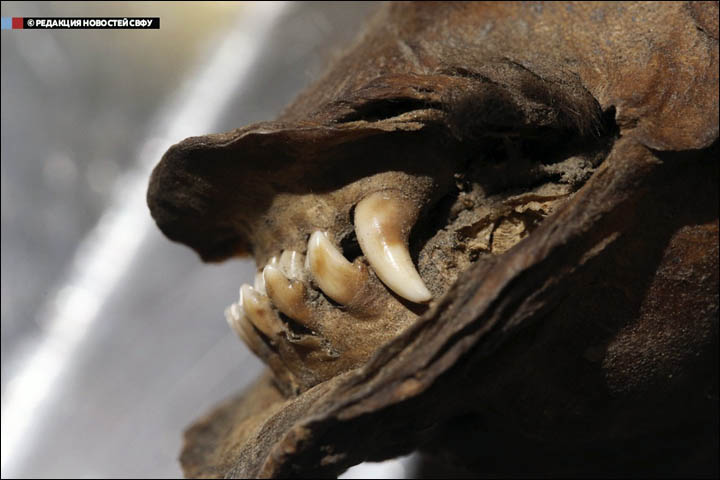The sibling of the Tumat Dog has been unearthed by researchers. This puppy, like the Tumat Dog, was mummified, and was found only twenty-six feet (eight meters) from its sibling. Both dogs lived more than 12,000 years ago; the Tumat Dog was discovered in 2011, and the other juvenile dog in 2015.
The more recent puppy is being called Pleistocene, because it lived during the Pleistocene era that ended about 12,000 years ago.
Researchers believe that both puppies were from the same litter and they died in either a landslide or burrow collapse in the Ust-Yansky district of northern Russia’s Sakha Republic. The second dog was found by the Museum of the Mammoth expedition from Federal University, located in northeastern Russia.
The Tumat Dog was found by two brothers, Yuri and Igor Gorokhov, and another person named Ayaan Tomsk. They then donated it to the mammoth museum. At the time, it was the world’s first, and only, fully preserved puppy carcass. Examination on the puppy revealed that it was female and aged around three months at the time of her death. Radiocarbon analysis dated it back around 12,400 years.
The preservation on the Tumat Dog was so thorough that scientists were able to recover what the puppy had eaten for its last meal.
According to the Siberian Times, the dog underwent a post-mortem examination in June 2015, four years after its discovery. During those years, scientist studied and tested the DNA — the remains were kept in a freezer to preserve them. What researchers now suggest is that both puppies are the ancestors of modern-day domestic dogs.
Professor Darima Garmaeva, from the Institute of Medicine, said at the time, “What is of real interest is the fact the animal has a completely preserved carcass, which is unique by itself, with nothing like it in the world.” Professor Garmaeva explained, “Although the tissues are mummified, they have no post-mortem decomposition, as usually happens with biological material.”
The post-mortem examination revealed that much of the animal’s insides were perfectly preserved, including its heart, liver, lungs and part of the intestine. The Tumat Dog’s stomach was also intact; when it was opened, the experts found two pieces of twig, measuring about 0.4 inches (one centimeter) in length.
This led to the theory that the puppy fell to its death during a landslide and had attempted to grab onto nearby foliage with its teeth on its way down. Further examination of the puppy will take place at a later date. In the meantime, some tissue samples have also been passed on to Tohoku University in Japan for analysis.
The head of the Tumat Dog research project is Sergey Fedorov, who is also the lead of the exhibition department of the Museum of the Mammoth. During an interview, he noted, “Near the place where the dog was found local people often find things that obviously belonged to ancient humans, such as stone implements and bone arrowheads.” He then went on to explain that the summer will find more archeologists at the site, trying to find any traces of humans, possibly the owners of the puppies.
One of the scientists taking part in the latest expedition to the site, Aleksandr Kandiba, said, “We have taken remains and artifacts from the site and will conduct additional research in our laboratories.’” The team hopes to trace the puppies’ lineage to modern-day dogs.
At the site, they hope to figure out whether the puppies were kept by humans or were part of a litter from a feral dog attracted by the possibility of picking up food scraps. Dr. Mietje Germonpre explained the theories currently being contemplated by researchers:
“There are two main theories. The first is that dogs arrived near sites where humans lived and picked up the scraps and gradually they co-existed.” said Dr. Garmaeva, from the Paleontology department of the Royal Belgian Institute of Natural Sciences and who traveled to Yukutsk to examine the site in August 2014.
“The second version talks about the active involvement of man, where the people themselves were the initiator of the relationship, and brought the puppies to their home and trained them.” He continued. “The data that I have accumulated speaks in favour of the latter theory. Now we can get more arguments.”
Professor Garmaeva summed up the importance of this discovery when he said, “What is of real interest is the fact the [Tumac dog] has a completely preserved carcass, which is unique by itself, with nothing like it in the world. Although the tissues are mummified, they have no post-mortem decomposition.”
Another equally fascinating discovery was made recently—although it is completely unrelated to the Tumat Dog, these finds are connected in that both include incredibly preserved remains. This discovery is that of “fantastically preserved” fossils of the oldest and largest species of sea scorpion ever found.
The location of the discovery: Iowa. Dating back 460 million years, the eurypterid species would have measured more than five feet (1.5 meters) long and had unique paddle-shaped legs to help it swim and dig. The weird shape of this fossil resembles that of the Greek warship penteconter and has been the source of its scientific name, Pentecopterus decorahensis. These giant, monster-like predators swam the ancient seas and are related to modern arachnids.
James Lamsdell, the lead author who hails from Yale University said, “The new species is incredibly bizarre. The shape of the paddle — the leg which it would use to swim — is unique, as is the shape of the head. It’s also big—over a meter and a half long.” He added, “Perhaps most surprising is the fantastic way it is preserved. The exoskeleton is compressed on the rock but can be peeled off and studied under a microscope. his shows an amazing amount of detail, such as the patterns of small hairs on the legs.”
